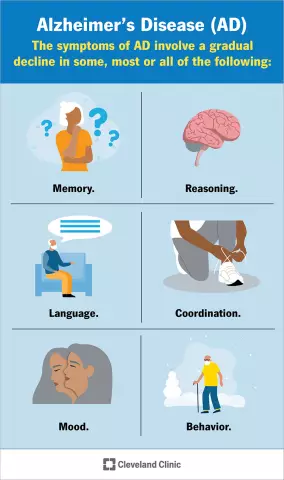- Author Rachel Wainwright [email protected].
- Public 2023-12-15 07:39.
- Last modified 2025-11-02 20:14.
Whipple's disease

Whipple's disease or intestinal lipodystrophy is a systemic disease of an infectious nature, characterized by lesions of the small intestine with typical infiltration of the intestinal mucosa by "foamy macrophages", gram-positive bacillus-like bodies. There is also an accumulation of lipids in it, expansion of lymphatic vessels, and the development of malabsorption syndrome. Whipple's disease develops mainly in men (30: 1) in the age group 30-50 years. According to various studies, about 30 cases of the disease are registered annually in the world.
Etiology of Whipple's disease
For the first time, Whipple's disease was described in 1907 by the pathologist J. Whipple, who, upon opening, discovered an increase in mesenteric lymph nodes with polyserositis. The bacterial nature of the disease was confirmed only in 1992. Tropheryna whipelii, gram-positive actinomycetes, have been identified using polymerase chain reaction. Actinomycetes are found in the active stage of the disease in the mucous membranes of the small intestine. The main reason for the development of the disease is currently assumed to be a violation of the functioning of the immune system of various origins. The active stage of the disease is characterized by the localization of bacteria in microphages, which indicates their loss of the ability to lysis of microorganisms. With the development of Whipple's disease, there is a reduced production of antibodies to the pathogen in the body or its complete absence. The lack of cellular immune response becomes more pronounced.
Despite the fact that the causative agent of the disease has been identified, the causes of the development of Whipple's disease are still unclear. Scientists do not rule out a genetic predisposition. Significant contamination with the pathogen of wastewater and soil does not lead to mass contamination. To date, not a single case of human-to-human transmission of Whipple's disease has been reported. Researchers believe that not all strains of the pathogen can develop Whipple's disease and its characteristic pathological changes.
The body's response to the introduction of the causative agent of Whipple's disease is pathological changes in organs and their systems. So, with Whipple's disease, the small intestine is affected first. Due to the dissemination of the pathogen Tropheryna whipelii, most patients have damage to the musculoskeletal system, central nervous system, cardiovascular system, and bronchopulmonary system.
Of particular importance in the development of Whipple's disease is the defeat of the small intestine and the local lymphatic system. The intestinal mucosa is infiltrated with microphages. There is an expansion of the lymphatic vessels, the accumulation of fat in the intercellular space of the mucous membrane of the small intestine.
Structural disorders of the intestines lead to the development of malabsorption, which makes it difficult to transport nutrients.
Stages of the disease. Whipple disease symptoms
During Whipple's disease, three stages are distinguished:
- The first stage, characterized by the manifestation of extraintestinal symptoms. At this stage of the disease, the main symptoms are polyarthritis, fever of unknown origin, muscle pain, cough with sputum production. The first stage of the disease can last from 3 to 8 years;
- The second stage of the disease is characterized by the manifestation of gastrointestinal symptoms. The main symptoms of Whipple's disease of the second stage are chronic diarrhea with profuse stools up to 10 times a day, abdominal pain, painful sensations on palpation (enlarged lymph nodes may be detected), decreased appetite, weight loss, muscle atrophy and muscle weakness. The most serious changes in Whipple's disease are disorders of fat and carbohydrate metabolism, polyhypovitaminosis, hypocalcemia, the development of severe malabsorption syndrome;
- The third stage of Whipple's disease is characterized by the development of extra-gastrointestinal symptoms, systemic manifestations. The third stage of the disease is characterized by impaired adrenal function (low blood pressure, nausea, vomiting, anorexia, skin pigmentation), signs of CNS damage (hearing and visual impairment, damage to the cranial nerves), damage to the cardiovascular system (endocarditis, pericarditis, myocarditis), skin changes.
Diagnosis of Whipple's disease

The variety of clinical changes in the affected organism makes it difficult to diagnose Whipple's disease. The main diagnostic method is the analysis of a biopsy (excised wall of the mucous membrane of the upper intestine), observation of morphological changes in the intestine during endoscopy. The most accurate method is PCR diagnostics (polymerase chain reaction), which allows you to determine the causative agent of Whipple's disease, both in a biopsy specimen and in other biological media.
Whipple disease treatment
For a long time, it was believed that Whipple's disease was fatal. The use of intensive antibiotic therapy makes the prognosis more favorable. Various antibiotics are used at the heart of the treatment of Whipple's disease. The most effective among them are drugs of the tetracycline series. The dosage and timing of therapy are determined on the basis of histological studies in each case individually.
In severe forms of the disease, patients often require additional symptomatic treatment.
To eliminate the symptoms of malabsorption, the patient is prescribed a special diet enriched with animal proteins with a limited fat content (up to 30 g per day). To eliminate the symptoms of diarrhea and abdominal discomfort, antispasmodics are prescribed to patients, which slow down intestinal peristalsis.
The effectiveness of the therapy used is assessed by repeated histological examination of the biopsy specimen. The main sign of the effectiveness of treatment is a decrease in the number of macrophages in the test sample or their complete absence. Symptoms of Whipple's disease may last a little longer due to the scale of organ damage.
The information is generalized and provided for informational purposes only. At the first sign of illness, see your doctor. Self-medication is hazardous to health!






